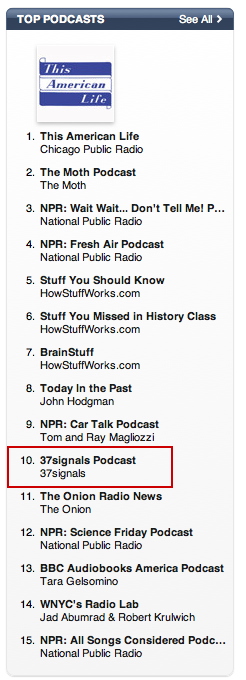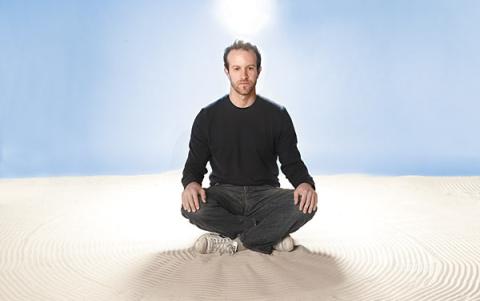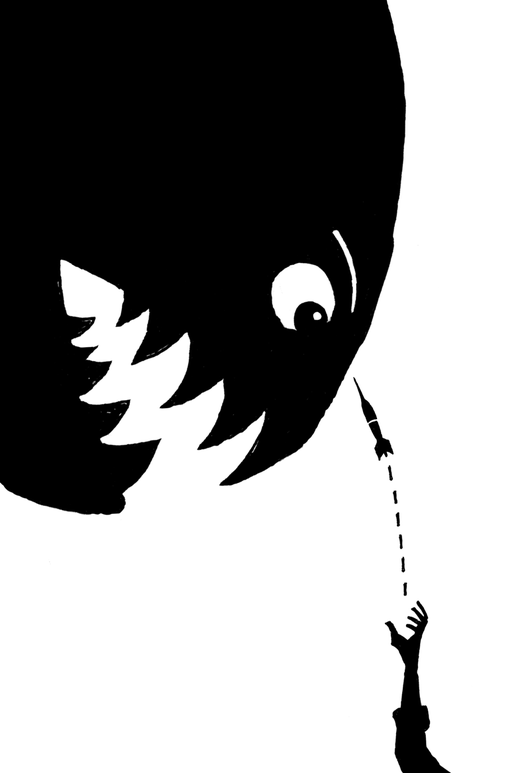Clutter is the official language used by corporations to hide their mistakes.
Inefficiencies are what make you special
The traditional advice for businesses is to “eliminate inefficiencies.” But a lot of the things that could be labelled as inefficiencies are actually what steer your product away from being a commodity. When you cut out anything that isn’t efficient, you wind up with a cookie cutter product.
Now that’s not to say you want your business to be riddled with random inefficiencies. It’s about what you purposely choose to leave in. It’s about deciding what’s important to your vision and then refusing to cut corners on those things, even if it might save you a few bucks.
“Customer Feedback Not on elBulli’s Menu” [via JK] is a Harvard Biz School look at Ferran Adrià’s restaurant El Bulli (ranked the #1 restaurant in the world). It talks about how streamlining operations at elBulli would turn it into just another restaurant.
There is much about the restaurant that is inefficient, as MBAs are quick to note: Adrià should lower his staff numbers, use cheaper ingredients, improve his supply chain, and increase the restaurant’s hours of operation. But “fixing” elBulli turns it into just another restaurant, says [HBS assistant professor Michael] Norton: “The things that make it inefficient are part of what makes it so valuable to people.”
Before you cut out something simply because it’s inefficient, ask if it’s adding value in some other way. Maybe spending extra to have pretty packaging or fresher ingredients or more durable stitching or a handwritten thank you note or whatever will wind up being why someone tells a friend about you. Often, the “wrong” things you choose to do are what set you apart and make your product unique. They’re the spice that make your dish special.
In the piece, Norton also uses Adria’s approach to highlight the distinction between understanding and listening to customers.
Adrià’s idea is that if you listen to customers, what they tell you they want will be based on something they already know. If I like a good steak, you can serve that to me, and I’ll enjoy it. But it will never be a once-in-a-lifetime experience. To create those experiences, you almost can’t listen to the customer…Adrià says he doesn’t listen to customers, yet his customers are some of the most satisfied in the world. That’s an interesting riddle to consider.
Charging for your product helps you find out who your customers are…We had all different types of people sign up for free [ScreenSteps Live] accounts including bloggers, educators and small businesses, but the only type of customer that signed up for paid accounts were those who were doing tech support. They were businesses and organizations that were in the middle of tech support nightmares. And ScreenSteps Live made the nightmare go away so they happily paid the monthly subscription fee. We instantly knew who our customers were. This guided both our marketing and development efforts.
Blue Mango Blog: Charging For Your Product Helps You Focus On Customers Instead of Users
Jim Collins and the "stop doing" list
Reader Tim Bailen writes in: “Thought you guys would like this idea — that a ‘stop doing’ list is more important than a ‘to-do’ list. It’s from Jim Collins’ study of companies that went from good to great.”
Most of us lead busy but undisciplined lives. We have ever-expanding ‘to do’ lists, trying to build momentum by doing, doing, doing—and doing more. And it rarely works. Those who built the good-to-great companies, however, made as much use of ‘stop doing’ lists as ‘to do’ lists.
Collins also discusses how “stop doing” lists can relate to one’s personal and professional life in this essay.
1) What are you deeply passionate about?
2) What are you are genetically encoded for — what activities do you feel just “made to do”?
3) What makes economic sense — what can you make a living at?Those fortunate enough to find or create a practical intersection of the three circles have the basis for a great work life.
Think of the three circles as a personal guidance mechanism. As you navigate the twists and turns of a chaotic world, it acts like a compass. Am I on target? Do I need to adjust left, up, down, right? If you make an inventory of your activities today, what percentage of your time falls outside the three circles?
If it is more than 50%, then the stop doing list might be your most important tool…
A great piece of art is composed not just of what is in the final piece, but equally important, what is not. It is the discipline to discard what does not fit — to cut out what might have already cost days or even years of effort — that distinguishes the truly exceptional artist and marks the ideal piece of work, be it a symphony, a novel, a painting, a company or, most important of all, a life.
That’s a good way to put it: You need the discipline to discard what does not fit.
37signals podcast hits top 10 at iTunes

The 37signals Podcast hit #10 at iTunes list of top podcasts today (and #1 in the Business category). Thanks to everyone who has subscribed! (Not subscribed yet? Sign up via iTunes or RSS.)
Recent 37signals interviews with UX Magazine, Time Out Chicago, and U. of Chicago Booth School of Business
UX Magazine published an in-depth interview with David. It’s a lengthy piece that touches on UI, business, programming, Getting Real, and more. Really comprehensive piece that’s worth checking out. Audio clips of the interview are included throughout too. (Also, check out the nice URL style the magazine uses.)
We keep comparing ourselves to the notion of chefs. When you walk into a high-end restaurant, you really don’t get a whole lot of choice. Usually, the hallmark of a high-end restaurant is the chef’s menu. The chef prepared courses of a dinner in advance where he made all the choices. You eat there because you trust the chef’s judgment and want his taste. Well, we try to do the same thing. Instead of just giving you a super-long menu, we’ll just give you this set course of plates and you’ll have to trust our judgment on it, and I think you’ll end up with a much tastier meal in the end.
Technically speaking is an interview with Jason that ran in Time Out Chicago.
Fried talks about how “making money is like playing the piano: The earlier you start, the more practice you’re going to have, the better off you’re going to be.” On the day he turned 13, Fried’s father, a Chicago Mercantile Exchange trader, took him to get a work permit. He worked typical jobs—grocery store, gas station, shoe store—but he always had a side business of his own. At 15, Fried got a resale license and began buying stereo equipment at wholesale cost, marking it up and selling it to friends. “I suck at playing the piano,” Fried says, “but I’m good at making money because I’ve had more practice.”
Check out the, um, heavenly image that ran alongside it:

Also, here’s a recent video interview and Q&A with Jason at the University of Chicago Booth School of Business:
Jobs at the 37signals Job Board: Facebook, Garmin, WGBH, etc.
Design Jobs
Garmin International is looking for a Associate Interactive and Animation Designer in Olathe, KS.
Justin.tv is looking for a Product Designer in SOMA/San Francisco, CA.
Facebook is looking for a Product Designer in Palo Alto, CA.
WGBH is looking for a Associate Developer in Boston, MA.
AKQA is looking for a Senior Designer in Washington, DC.
gravitytank is looking for an Interaction Designer in Santa Monica, CA.
Programming Jobs
ekoVenture is looking for a Ruby on Rails Developer in San Francisco, CA.
Gen2Media Corporation is looking for a Senior PHP/MySQL Developer in Orlando, Florida.
Advantage Interactive Ltd is looking for a Ruby on Rails Developer in Hertfordshire, England.
Arc90 is looking for a Web Application Developer in New York, NY.
SingleFeed is looking for a Lead Engineer in San Francisco, CA.
Epoch is looking for a Rails Programmer in Santa Monica, CA.
View all Programmer Job listings
More jobs
View all of the jobs at the 37signals Job Board. (The Job Board now has internships too.)Creative Haystack listings
It’s a blast scrolling through Haystack for design inspiration. Along the way I’ve been making a list of some of the more interesting ads. Here are a few especially creative ones I wanted to highlight:
An ad instead of an image
These listings get creative by using the image space to create a billboard instead of showing off a portfolio piece.

Midnet Media in Columbus, OH. Love the use of the Haystack cards in the design. Very clever!
Multiple images instead of a single image
Free Haystack listings only include one image, but these guys got creative. Nice hack. Bonus points for working around the perceived rules.

Three Square Design in Boston, MA.

Joshua Mauldin in Los Angeles, CA
Using the logo for something other than a logo
Haystack has a space for your logo, but these creative folks used the space for something else. I love it.

Item 9 Consulting in Chicago, IL went with a stylized text message.

Phil Dokas in Ann Arbor, MI dropped his face in there.
Got a favorite?
Got a favorite Haystack listing? Drop us an email at contact@haystack… and we may highlight it on our next post. And if you’ve found work or a design firm using Haystack, please let us know so we can add you to the Haystack success page. Thanks.
REWORK goes international + illustration preview
It’s true, REWORK won’t be out in the US until March 9, 2010, but you’ll also be able to get translated versions in a variety of other languages and countries. The release dates may be later than the US version, but eventually you’ll find REWORK from the following publishers in the following languages/countries:
- Indonesian (Publisher: PT Gramedia Pustak)
- China (Publisher: China Citic Press)
- Dutch (Publisher: Uitgeverij Mouria)
- UK (Publisher: Vermilion)
- Germany (Publisher: Verlagsgruppe Random House)
- Japan (Publisher: Hayakawa Shobo)
- Portuguese/Brazil (Publisher: GMT Editores Sextante)
- Spanish (Publisher: Ediciones Urano S.A.)
We thank all the publishers above for trusting in REWORK.
Pre-orders
If you want to get in early, you can pre-order the US version from the following booksellers:
Original art preview
REWORK will also contain 50 original illustrations from one of our favorite illustrators. Can you guess who it is? We’ll reveal the artist’s name, as well as more illustrations, as we get closer to publication date. Here’s a preview:

I have only ever designed products that I myself would like to live with so it goes without saying that we live with Braun products and Vitsoe furniture. As a designer, it is only by using your products daily that you are able to tell what sorts of improvements may still be needed.




